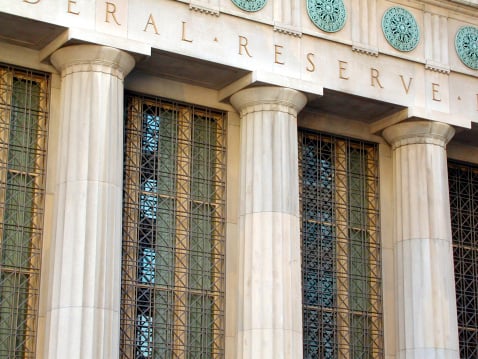Economy
NY Fed Dudley Talks Rate Hike Timing and Actual Benefit on Lower Oil
Published:
Last Updated:
William C. Dudley, President and Chief Executive Officer of the Federal Reserve Bank of New York, has made some comments regarding the timing of when interest rates would likely rise. He also made comments regarding the impact of lower energy prices. His speech was titled “The 2015 Economic Outlook and the Implications for Monetary Policy” and was delivered at the Bernard M. Baruch College in New York City. Source: Thinkstock
Source: Thinkstock
The long and short of the matter is that Dudley believes that interest rates will rise in mid-2015. He is calling for 2015 gross domestic product (GDP) to be 2.5% to 3% in the United States. Another note was that U.S. households are carrying less debt, with total household liabilities currently about $500 billion below their cyclical peak in 2008. Dudley even quantified the benefit of the lower oil prices at the consumer level: a $20 per barrel decline in global oil prices results in an income transfer of roughly $670 billion per year from (oil) producers to consumers.
On the rate hike views, Dudley said:
I hope the FOMC can begin to raise its federal funds rate target next year. This would signify that the economy has made sufficient progress towards the FOMC’s objectives and that the time had finally come to begin to unwind the current high degree of monetary policy accommodation.
ALSO READ: 5 Big Dow Dividend Hikes Expected Before 2014 Ends
Here were his formal comments around the oil and energy situation right now:
Another positive development for both the U.S. and the global economy is the sharp decline in energy prices. Let’s start with the U.S. perspective. Despite the impressive recent gains in natural gas and crude oil production, the U.S. still is a net importer of energy. As a result, falling energy prices are beneficial for our economy. In economist parlance, falling energy prices are a positive “terms of trade” shock for the U.S. Over the near-term, this will lead to a significant rise in real income growth for households and should be a strong spur to consumer spending. Since energy expenditures represent a higher proportion of outlays for lower income households, falling energy prices disproportionately raise their real incomes. Also, because such households are more liquidity constrained, with budgets that often bind paycheck to paycheck, they have a higher tendency to spend any additional real income. As a result, much of the boost to real household income from falling energy prices is likely to be spent, not saved.
More broadly, the decline in energy prices also will be supportive to the global growth outlook in two other ways. First, by pulling down inflation in many countries it will spur more expansive monetary policy. We are already seeing this response in Europe and Japan. Second, the decline in energy prices is also likely to ease the global fiscal stance. Over the near-term, for oil exporting governments, falling revenue will not be fully offset by reduced expenditures. This will cause major oil exporters to run either smaller budget surpluses or bigger budget deficits. In the aggregate, the swing from oil producers to consumers is quite large. For example, a $20 per barrel decline in global oil prices results in an income transfer of about $670 billion per year from producers to consumers. This understates the total effect because it does not include any knock-on reductions in other energy prices—such as for natural gas—that, outside the U.S., often are linked to oil prices.
Obviously, if the oil price declines were to both intensify and persist, this would have negative implications for oil and gas investment in the U.S. At a minimum, as cash flows fall, some producers will cut back on their drilling activity rather than plug the shortfall with outside financing.
Nevertheless, there are several reasons why I don’t think this risk should be overstated, especially if oil prices stabilize around current levels. First, even after the large gains in recent years, oil and gas investment remains a small fraction of GDP. Second, domestic natural gas investment should be relatively unaffected because U.S. natural gas prices are largely insensitive to global energy price developments. This reflects the high costs associated with exporting natural gas and the fact that most of our oil production is used for transportation purposes. Thus, the ability to substitute lower cost natural gas for oil is limited. Third, extraction costs vary appreciably across the different major oil fields. There is not a single critical price that will constrain production or investment. Fourth, with respect to oil produced by fracking, productivity gains have cut drilling costs and raised oil production, so breakeven costs per barrel have been falling. Finally, if oil investment were to soften, this would lead to lower breakeven costs as resources currently in short supply—e.g., water, welders, housing and transport—became more available and less expensive.
ALSO READ: America’s 50 Best Cities to Live
Want retirement to come a few years earlier than you’d planned? Or are you ready to retire now, but want an extra set of eyes on your finances?
Now you can speak with up to 3 financial experts in your area for FREE. By simply clicking here you can begin to match with financial professionals who can help you build your plan to retire early. And the best part? The first conversation with them is free.
Click here to match with up to 3 financial pros who would be excited to help you make financial decisions.
Thank you for reading! Have some feedback for us?
Contact the 24/7 Wall St. editorial team.